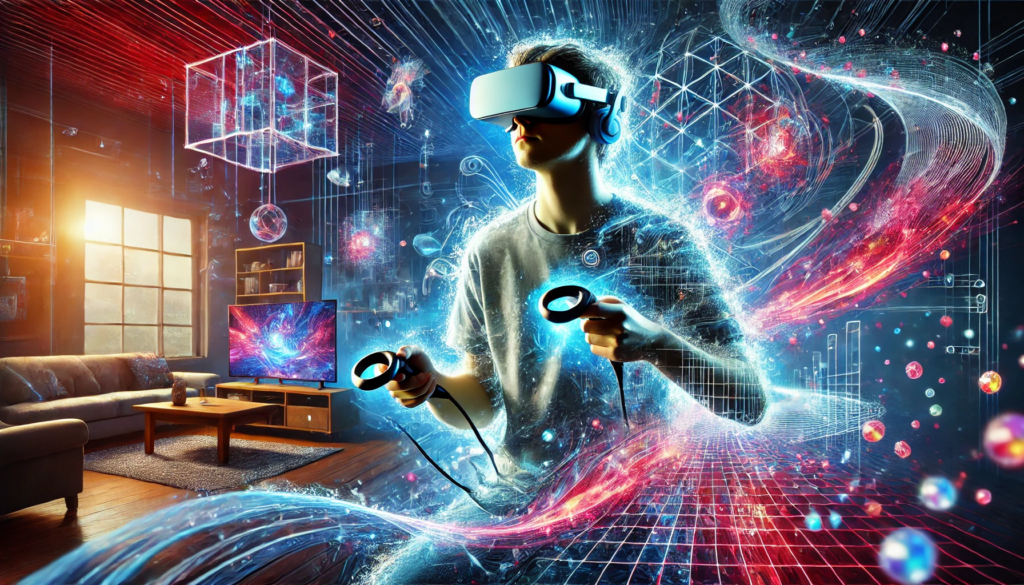At the core of VR’s appeal is its ability to create a sense of presence—the feeling of truly being inside a virtual world. Physical activity plays a pivotal role in enhancing this presence. When players use their bodies to interact with the virtual environment, whether it’s swinging a sword, ducking behind cover, or reaching out to grab objects, the immersion and the delineation between reality and the virtual world are diminished more than in any other gaming experience.
For the last nine generations of game consoles, improvements have been dictated by Moore’s law—more general computing capacity for a similar price/form factor for each successive generation, usually launched about every five years. Improvements include rendering speed, graphics capacity, online connectivity, and more detailed environments.
The initial launch of consumer-viable VR headsets in the mid-to-late 2010s saw the first divergence from this principle, where a new medium was more computationally expensive than flat screen equivalents, forcing VR games to sacrifice the evergreen principles of graphical improvement. This trend has become more exacerbated with the transition from PC-powered VR to standalone devices—meaning all of the device’s computing power is built into the headset rather than delegated to a dedicated computer. For example, the standalone Quest 3’s computing power is roughly equivalent to the Nvidia GTX 960, a mid-level GPU from 2015.
While not winning a computing war, VR benefits from a bespoke and exceptional feature—6 degrees of freedom and the immersion of player embodiment. The hallmark tenet for building a VR game is to make it the best and only possible in VR. If the core loop and design don’t utilize the platform’s unique features, then it must directly compete with high-compute, lower-friction devices (PC & console). The best of these games utilize mechanics that would be near impossible to replicate without a VR setup.
Games That Achieve Embodiment and Physical Activity
Note: While these titles brought about unique-to-VR movement components, the success of these titles is multifaceted.
Beat Saber
Beat Saber was one of the first viral, successful games for VR—a rhythm game where players hit moving music notes propelling towards them. Rhythm isn’t a new category; games like Rock Band and Guitar Hero dominated the 2000s with a similar concept of scoring notes with timing precision. Beat Saber brought this concept to VR. Not only does the game take place in 3D space, but it also utilizes physical player movement to play. Users have to strike blocks by moving their physical hands and must physically move sideways or downwards to avoid obstacles coming toward them. This has made the title incredibly popular and a surprisingly good workout. Most notably, it validated the idea that top experiences in VR are unique to VR.
Superhot VR
Superhot VR exemplifies the “best & only possible in VR” principle while still being derived from an original flat screen release. The game’s core mechanic—time progresses only with player movement—is brilliantly adapted for VR. This creates a unique mix of strategy and action intrinsically linked to the player’s physical movements. Every slight gesture advances time, generating an intuitive connection between player action and game progression that traditional controllers can’t replicate.
Superhot VR leverages VR’s capacity for 360-degree awareness, requiring players to constantly survey their surroundings. This spatial interaction, combined with natural gesture-based controls for actions like punching, throwing, and shooting, enhances immersion in ways button inputs literally can’t match.
The game’s core loop, paired with its physical interactions, generates a powerful sense of presence. Players find themselves fully immersed in a surreal, time-bending world, manipulating time and space through their own movement—making the 2D version pale in comparison.
Gorilla Tag
The most popular VR game to date, Gorilla Tag stands out as the prime example of a game that fully embodies the “best & only possible in VR” principle. While Gorilla Tag’s core driver is its social playground, its brilliance lies in how it leverages VR movement to create a unique locomotion system that would be impossible to replicate on traditional gaming platforms.
Players move by using their arms to propel themselves, mimicking the movement of gorillas. This innovative approach to locomotion creates a physically engaging experience that’s intrinsically tied to VR’s motion controls. The game transforms the player’s entire body into a controller, requiring them to swing their arms to move and climb, creating a sense of embodiment that’s uniquely possible in VR.
The game’s multiplayer aspect further capitalizes on VR’s strengths. Players must be constantly aware of their surroundings, looking around to spot other players and using the full range of motion afforded by VR to dodge and chase. This spatial awareness and physical engagement create a social experience that’s both intuitive and deeply immersive.
As mentioned before, the success of these titles is greater than just their unique-to-VR movement mechanics, but it is a defining pillar to their success. In essence, the future of VR gaming lies not in competing with traditional platforms on graphical prowess but in pioneering experiences that are uniquely suited to the medium. By embracing VR’s strengths—immersion, physical interaction, and spatial awareness—developers are creating games that justify the technology and offer players something genuinely novel.
As the industry continues to evolve, the most successful VR titles will likely be those that fully embody the “best & only possible in VR” principle, pushing the boundaries of what gaming can be and redefining consumer expectations of interactive entertainment.


